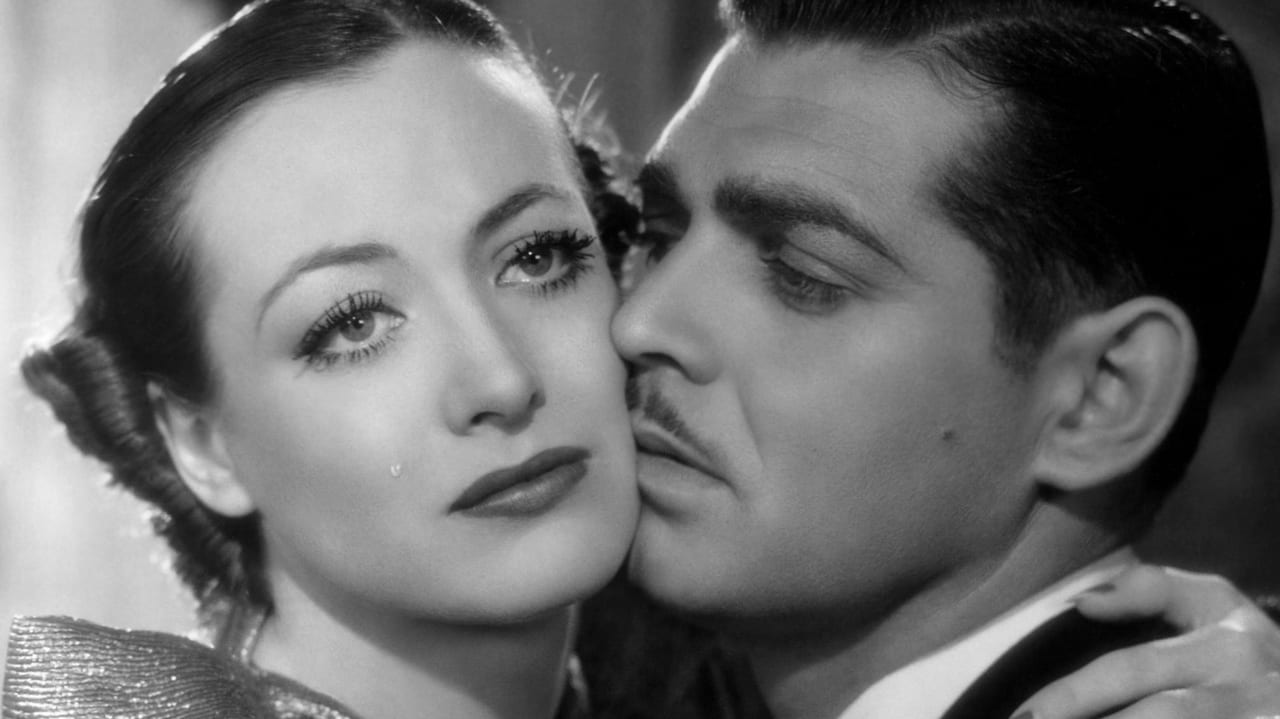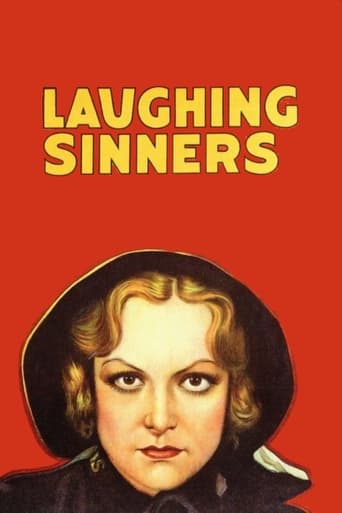

One of the best films i have seen
... View MoreLoad of rubbish!!
... View MoreBad Acting and worse Bad Screenplay
... View MoreThis is one of the best movies I’ve seen in a very long time. You have to go and see this on the big screen.
... View MoreLAUGHING SINNERS (Metro-Goldwyn-Mayer, 1931), directed by Harry Beaumont, is a dramatic story that may contain some sinners in the cast, but in the most part, are not laughing, except for a scene involving a drunken party. The movie in question happens to be a new title to a Broadway play "Torch Song" by Kenyon Nicholson, starring Joan Crawford in her mission of mercy. Not as well known as one would expect, it's more notable for being Crawford's rematch under the direction of Harry Beaumont from DANCE, FOOLS, DANCE (1931), along with actor on the rise by the name of Clark Gable, elevated in the cast from seventh in the previous film to third in this latest edition. While Gable played mean tough guys in such 1931 releases as THE PAINTED DESERT (Pathe), NIGH NURSE (Warner Brothers), THE FINGER POINTS (First National), and reaching the peak of his career treating Norma Shearer rough in A FREE SOUL, LAUGHING SINNERS offers Gable an opportunity playing a nice guy as he did earlier in THE EASIEST WAY (1931), an image he would soon endure through much of his career from this point forward.The story opens as a Pembroke train station on a rainy night where Ivy Stevens (Joan Crawford) runs to and on board the passing train where she meets with Howard Palmer (Neil Hamilton), a traveling salesman whom she has known for two years. This time she joins him and his fellow salesmen, Fred Geer (Roscoe Karns), "the sardine king," and Mike (Cliff Edwards), the ukulele singer, to their next stop. Spending time with Howard, Ivy acquires a cabaret job singing and dancing for its patrons, where she has become close friends with an older showgirl, Ruby (Marjorie Rambeau). During a performance where Ivy dedicates a song to the man she loves, Howard, it is Howard who then writes her a farewell note as he is about to run off and marry Estelle, the bosses daughter. Totally distressed and betrayed, Ivy takes a walk to jump off a bridge. Her chances of suicide are stopped by the passing Carl Loomis (Clark Gable), a Salvation Army man, who talks her out of destroying her precious gift of life. During the course of a year, Ivy, now a member of the Salvation Army, and winning new friends, meets up with Howard again. Although still married, he wants to win her back and return to her life of sin. Others in the cast include: Guy Kibbee (Cass Wheeler, a mortician salesman of "underground novelty" a role Kibbee reprised from the stage); Gertrude Short (Edna); George Cooper (Joe); George Marion (Humpty, the cabaret manager);, Clara Blandick, and the dark haired, thin faced Mary Ann Jackson from those early "Our Gang" comedies for Hal Roach as the little girl in the picnic scene at Lincoln Park.As in DANCE, FOOLS, DANCE, Crawford displays her singing and dancing ability with her night club singing, first with her "Red Hot Dance" dressed up like a bearded hillbilly in overalls and false nose; and a solo torch song spotlight singing "What Can I Do? I Love That Man" by Martin Brones and Arthur Freed.A major change in Gable's recent villainous performances to a wider range of his newfound character. Still minus his famous mustache, Gable again gathers much attention in his second of eight collaborations opposite Crawford that would last until another religious themed/prison story, STRANGE CARGO (1940). Neil Hamilton, resumes his second lead performance as he did in other MGM productions, and Cliff Edwards, who had a sizable role in DANCE, FOOLS, DANCE, has little to do this time around. Other than her dancing and her character part of the Salvation Army crew, the big surprise here is finding the dark-haired brunette Crawford becoming a dark-haired blonde.LAUGHING SINNERS succeeds mostly through its casting and little on its direction, but overall, a passable 72 minutes of betrayal and redemption story from a woman's point of view. Available on home video and DVD as well as broadcasts on Turner Classic Movies, especially during either Crawford or Gable tributes and festivals. (**1/2)
... View MoreLaughing Sinners (1931)This is your typical Joan Crawford vehicle, but she brings on a relative new actor into her movie, Clark Gable. This is before Gable gets typecast as the ultra-masculine and sexual gigolo (and many times bad guy). So, it's a refreshing portrayal. Ivy 'Bunny' Stevens (Crawford) is a night club dancer and singer (with a heart of gold), but has it bad for her traveling salesman boyfriend, Howard Palmer (Neil Hamilton). When Howard dumps poor Ivy for his rich bosses daughter, Ivy takes it hard and is about to jump off of a bridge when a very friendly Salvation Army man, Carl Loomis (Clark Gable) stops her and gives her something else to live for.Good-hearted Carl isn't preachy. He's fallen far from grace himself and can't judge anybody. When Ivy meets back up with Howard, who puts the moves on her, she regrets falling for his lines the next morning and doesn't feel worthy. Carl, true to form, doesn't blame Ivy, telling her that if she wants to go back with Howard and that will make her happy, that he's all for that, but she shouldn't feel like she's not worthy to come back to the Salvation Army, because we all fall from grace sometimes. Naturally, Carl doesn't feel the same for Howard and gives him a nice sock on the jaw.
... View MoreKenyon Nicholson's play "Torch Song" ran for 87 performances on Broadway, closing in November 1930; this film adaptation was released in May of the following year, and some historic reviewers who had seen the original play complained about the radically different ending added to the movie. "Laughing Sinners" was lightened up considerably over the stage version, and according to Crawford the whole film was shot with Johnny Mack Brown in the role ultimately awarded to Gable, being re-shot with Gable on the orders of Louis B. Mayer. On Broadway, Crawford's role was portrayed by ill-fated actress Mayo Methot, later to marry Humphrey Bogart.It is directed by Harry Beaumont, who handled Crawford's silent jazz baby films and later, "Dancing Lady." For Crawford, "Laughing Sinners" straddles a precipice between her singing and dancing activity and that of more serious drama; although already a star, her 1932 entries -- "Grand Hotel" and "Rain" -- would propel her status and popularity well beyond that of 1931. While it is a huge improvement over terribly stiff talkies like Garbo's "Anna Christie," "Laughing Sinners" is not Beaumont's best work, and the musical sequences are in some ways still the best thing about it. Crawford dominates the first half of the film and it's her boundless energy and enthusiasm that drives it. She is especially beautiful here, and her eyes radiate emotion; in the scene where she receives the "dear Jane" letter from first-class-heel Neil Hamilton, the reaction is played entirely through Crawford's ominous orbs. The most remarkable thing about it, though, is that Gable refuses to lay down and to let Crawford run away with this picture, which may have been what Mayer had in mind when he recast the role; this would prove the first of eight pictures Gable and Crawford would make together. In a sense, this picture feels like a "test" for the principals and, if so, Neil Hamilton fails it; he is stiff and colorless and one wonders why Crawford's dynamic character could be so head over heels with such a back-slapping good buddy. Some have mentioned that "Laughing Sinners" strains credibility somewhat, but within the context of 1931 the whole piece is well within the realm of the plausible; many American joined up with service and charity organizations such as the Salvation Army as a way to weather the economic depths of the depression. There are many scenes in "Laughing Sinners" that depression audiences could relate to, such as Crawford's spartan accommodations and the meal that Crawford and Gable share. The original play was set in a hotel and train station in Pomeroy, Ohio, and Ohioans will note references to Ohio place names, though there are no native exteriors.
... View MoreA decent early vehicle for Joan Crawford. Crawford plays a loose woman who tries to turn her life around after being jilted by her lover. The movie also sports a young Clark Gable as the Salvation Army worker who comes to her rescue. All the acting is pretty good, and the story had potential. In one very well played scene, Crawford's ex-lover succeeds in seducing her once again, despite having nearly ruined her life once already. The rest of the film, though, really fails to pack a punch. The happy ending comes off as rather unbelievable and bland. The movie was probably done better a few years later under its original stage title, Torch Song.
... View More